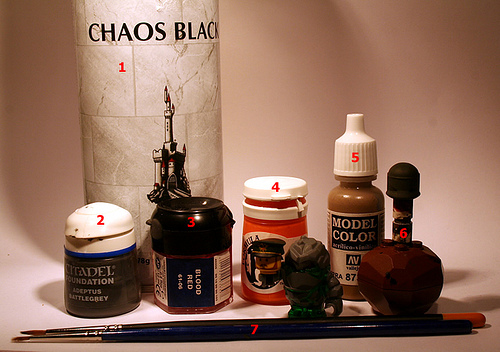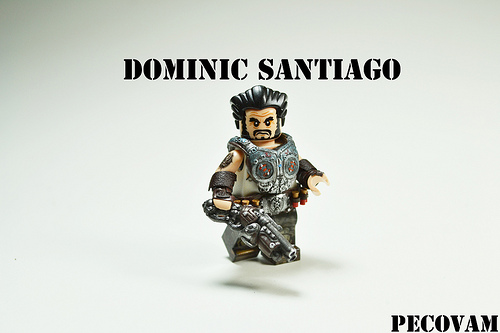In our first guest post from Jasbrick, we learned about how to get started with minifig customization. Now, let’s hear what he has to say about the tools of the trade.
Now that you have a concept and have gone as far as you can by conventional means it is time to bring in the tools. The range of customisation techniques mean that even with limited tools you can get some pretty impressive results without breaking the bank.
Painting and re-colouring
 I use painting to add details or re-colour parts that would not otherwise be possible.
I use painting to add details or re-colour parts that would not otherwise be possible.
For example the following minifig fits the steampunk genre with its almost rust / bronze coloured metallic effect which would have been impossible with the original bright white Buzz Lightyear original scheme.
Those of you who have everything you need but with parts that are not quite in the colour you want have two options: Dyeing or Painting.
Dyeing using vinyl dyes works well with parts that you want to change completely, but is limited in colours available and achieving a particular tone can be tricky.
Painting can offer more flexibility in colour choice and coverage, however the biggest downside is that painting plastic is difficult. I see examples every day of great custom concepts that are ruined by the quality of the painting. As painting is a favourite technique of mine I will go into much more detail on this and how to avoid creating a dull, streaked and unconvincing paintjob.
The key tools you need for painting are shown in the image below:

- Spray undercoat (essential for smooth painting on a plastic surface);
- Games Workshop Foundation paints (high opacity paints that give a good coverage with a single coat;
- Games Workshop Normal paints (good range and availability);
- Privateer Press P3 paints (slightly better quality than GW paint in my opinion, smaller range of colours and poor availability);
- Vallejo Paint (Excellent range of paints that also has colour range that is named after military colour schemes e.g. Lluftwaffe Blue);
- My device for holding helmets / heads for painting;
- Games Workshop brushes of various sizes.
The most crucial of all is the spray primer, as painting a smooth coat onto plastic is virtually impossible without it. Spray primer covers the part with a very thin layer of paint which is much more likely to bond with the plastic and not scratch off easily. Subsequent coats of paint adhere to this base and settle without streaks or chipping. So if you want a minifig helmet to be a nice shade of dark blue to match your plan for a Judge Dredd figure then you need to spray it before applying the perfect paint colour.
Your choice of paints is also important and I suggest you experiment with different types before applying to a Lego part. Characteristics like price, coverage, mixing, drying time, finish and colour choice all need to be considered. I personally use the Games Workshop model paint range as they score highly on all of the above criteria (except price). Games Workshop also have a great range of inks for washing and foundation paints for good coverage. Other good ranges are Vallejo and Privateer Press P3. All of these sell starter sets which contain a good selection of paints and brushes to get you started.
With paint brushes it is not just about size but how you use them that counts… You will need to have good quality model brushes in three main sizes: fine detail, standard and basecoat. Working out the right brush for the job is essential as a small brush will not cover a large area as smoothly as a basecoat brush. As with most things brush control improves with practice and it is advisable to test your new skills on something less precious than your rare minifig part. The following is an example of fine brush work:

This wrestler’s mask was painted freehand with a fine detail brush in multiple layers.

The joker here has face details that were painted on freehand and the hair which was primed and then painted with a dark green colour using a basecoat brush.
Painting detailed designs requires not only brush control but paint control as well. Another obvious problem in some custom work is the thickness of paint application and poor layering. Experience in handling paint can be shortcut by the use of a tool known as a Wet Palette. These are so easy to put together and it is definitely going to improve your paintwork. Quite simply all you need is a small tray, about the size of an 8 x 16 brick, and some absorbent cloth or paper towel. Put the cloth in the tray and then add water to it until the cloth is completely damp… That is it, now all you need to do is transfer your paint to the wet palette before painting on the part. The damp cloth waters down the paint slightly, keeps the paint from drying and also allows you to mix with more control.
There are a whole host of tutorials on the internet for how to create a wet palette and how to paint, however I hope to bring more Lego-specific tutorials to you in the near future.
An important part of painting is the final finish. Paint applied properly will be more resilient than you think possible. However, to seal the deal you can use a varnish to protect your work. Varnishes can be matt or gloss, with the latter being particularly useful for returning a shine comparable to pure unadulterated plastic.
The Brothers Brick is funded by our readers and the community. Articles may include affiliate links, and when you purchase products from those links, TBB may earn a commission that helps support the site.



















